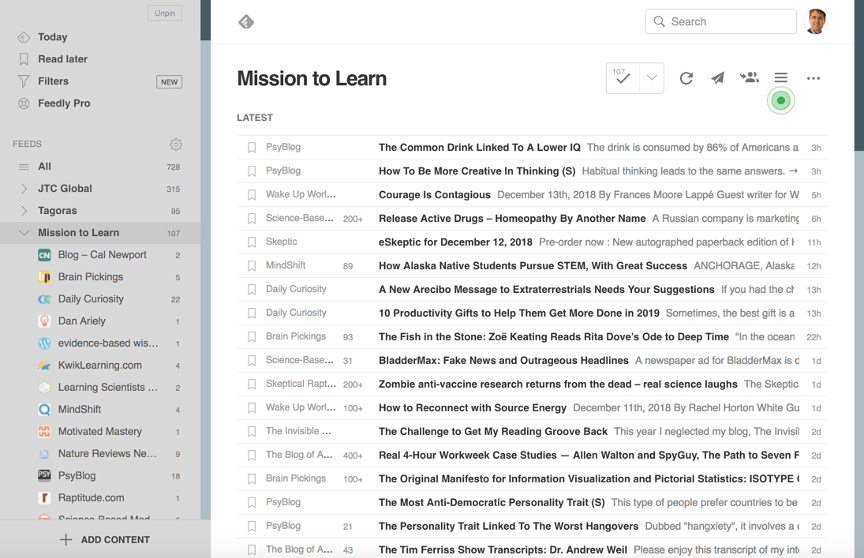For the individual lifelong learner, one of the greatest opportunities of our age is the sheer volume of content we now have access to through the Internet.
If we want to expand our knowledge on any topic, simply pulling out our smart phones and doing a quick Google search will lead us to a wealth of resources. With enough time and motivation, there are very few limits to what we may be able to learn
It’s a huge opportunity. But I probably don’t have to tell you that it is also a huge challenge.
The same resources that can help us can also quickly overwhelm us and leave us with more questions than answers.
How do we decide which resources are most worth our time?
How reliable are the sources of any information we find?
How do we manage to remember any important information we find?
We need an approach to managing it, making sense, learning. That approach can be described as curation.
What is Curation?
So, what does curated mean? And what is a curator?
The concept of curation is most often identified with museums. A skilled museum curator chooses among a wide range of objects – anything from paintings, to dinosaur bones, to ancient relics, depending on the type of museum.
Then, by the way in which she organizes and displays them, she creates a context and story that connects them together, giving them much more meaning than they would have on their own.
An effective curator of learning does much the same thing
Curating for learning involves making choices about content and experiences from among a large number of options; infusing those choices with context and meaning; and sharing the results with others.
Very common examples are the people you find in just about any field or industry who seem to read an enormous amount, filter it all down into a handful of useful Web links, write brief commentaries on the links, and then send it out periodically in the form of a newsletter. There’s a good chance you already subscribe to one or two newsletters that you rely on to help you make sense of what is going on in your world.
And that, fundamentally, is what curation is all about: helping people – including yourself – make sense.
Leveraging Curation for Learning
So how can you leverage curation and curated content as part of your ongoing pursuit of lifelong learning?
First, you can find and follow good curators.
If you want to combat information overload and get to what really matters, I see this as one of the surest ways. Find people who are already doing a great job making sense of the areas you care about.
There’s a good chance you are already aware of some of these people. For example, they may be:
- People who consistently contribute the most interesting content to any blogs, newsletters, magazines, or other content sources you access regularly
- Authors who have published books on topics you care about
- Speakers who have impressed you at any conferences you’ve attended
Not all of these people will qualify as curators, but with a little searching among this group, you will find some who clearly possess the qualities of a good curator and make an ongoing effort to find and share useful information. They may do this through a blog, a newsletter, social medial, or some combination of these channels.
And, of course, to find other sources of curated content, you can search on Google and social media channels like Twitter or LinkedIn on topics you care about the most. Based on your results, you may find specific people you want to follow, or you may choose to follow keywords from your Google search (e.g., “lifelong learning”) or hashtags on social networks (e.g., #lifelonglearning)
But how do you do all of this following?
With newsletters, of course, all you have to do is subscribe, but I also recommend setting up one or more folders in your e-mail program where you file away the e-newsletters you receive. This makes it easy find them later and review multiple newsletters at one time.
Following blogs and social media channels is a bit more complex, but one tool that makes it tremendously easier is an RSS reader like Feedly or Inoreader. There are free versions of both of these tools and you can use them to pull content from blogs and keywords searches into a single dashboard where you can organize them and make then easy to review and refer back to over time.

You can even use a tool like FetchRSS (free version available) to make an RSS feed out of Twitter feeds, public Facebook Pages, and just about any Web page. These, too, can be managed in a reader like Feedly or Inoreader. (You can even subscribe to newsletter via RSS using the free Notifier service.)
When you first start out, you may find that you end up subscribing to or following a lot of sources. That’s okay – you can and should pare down and refine over time, until you get to the set of curated content that is most consistently valuable to you. (Unsubscribe and Unfollow are options that need to be continually exercised!)
One final word of advice: don’t just pick curators who seem to always be towing the same old line and writing about things you already know and believe in. Find some who clearly have perspectives and opinions that are different from yours.
One of the dangers of the social Web is that we tend to gravitate, often unconsciously, toward people who seem like us in some way. As a result, we can end up in an “echo chamber” where we hear the same sorts of things again and again. It is very hard to learn, though, if you aren’t really being exposed to anything new!
Becoming a Curator
Once you have started following curators, you are actually well along the path to becoming a curator yourself. After all, you are already actively finding and reviewing information on topics you care about.
With just a bit more thought and effort, you can leverage your efforts into becoming a source of knowledge and learning others will want to follow. Along the way, you will enhance and deepen your own learning significantly as you think about how to curate effectively for others.
How do you do all of this this? First and foremost, you need a strategy and a process.
Curation Strategy
Creating a strategy may sound daunting, but an effective curation strategy really comes down to just four key elements.
- Who? – Who will you be curating for? Most likely your target audience will be people who share something in common with you – like, for example, working in the same field or industry. I recommend trying to picture a few examples of potential followers in your mind and maybe even writing down what you feel are some of their most relevant characteristics.
- Why? – What is it you want to help your “Who” do? How will what you curate be used? Having your audience’s motivations and the outcomes they want to achieve in mind makes it much easier to identify the content that it will be most valuable to share.
- What? Given what you know about “Who” and “Why” what types of content and experiences seem most valuable? You may not know exactly at first, but develop some working theories and start trying them out to see what kind of response you get (e.g., clicks on articles you share, people e-mailing you with comments or questions).
- How? What medium and frequency make sense for sharing the knowledge you curate? I’ve mentioned newsletters, but those certainly aren’t the only option. A blog, a Twitter feed, YouTube, or some other channel may make more sense for your Who, Why, and What. And, should you send out resources daily, weekly, monthly? Again, you may not know for certain at first, but develop a theory based on what you do know and give it a try.
With a strategy in place, you are ready to engage in the curation process.
The Curation Process
There are many ways to go about curating knowledge and learning experiences, but all of them, when done effectively, involve the following six elements:
- Discover – To have content to share, you first have to find content that is a good fit for your Who, What, and Why. We discussed this part of the process in the previous section.
- Organize – As you find content, you need to create order from the chaos. As already suggested, a simple approach is to throw everything into one or more e-mail folders so that you can sort through them later. If, on the other hand, you use a tool like like Feedly or Inoreader, you can easily use categories and tags to group similar items together and make them much easier to find later. You can even add notes to items to make sure you will remember just why you saved them.
- Contextualize – This is where the real value of curation starts to be realized. Using whichever medium you have chosen for sharing your findings – text, audio, video, or some combination – you add explanations, draw comparisons, connect the dots between the items you have discovered and the world of your followers. In the process, you add a dose of your own perspective and personality.
- Share – Once everything is organized and contextualized, the time has come to share all the value you have created with your audience. Some curators do this through a single channel, like an e-mail newsletter, but you may want to take advantage of multiple channels. In addition to sending out the curated Mission to Learn newsletter, for example, I also share curated items on Facebook and Twitter. Some of these may also be in the newsletter; some are “bonus” content.
- Monitor – One of the best ways to improve your curation efforts over time is to pay attention to what prompts a response from your audience. Which of the items you share get clicked on? Commented on? Shared or liked on social media by your followers? These are metrics that the platforms you choose to share content on will most likely have easy ways of tracking – and they help you know whether you are hitting the mark or not.
- Refine – Finally, based on what you learn from the other parts of the process, what changes will you make going forward? As part of the process, you may find new content sources. You may find that one channel (e.g., Facebook) seems to work much better than another for sharing content (e.g., e-mail newsletter). You may find that you are hitting the mark better in some areas of your content than others. Over time, as you receive this feedback and make changes, your curation efforts will become more and more valuable.
If it is not obvious already, the process outlined above is very much a learning process. As you seek to help others you will inevitably find that you learn a tremendous amount yourself, not just about your chosen topic areas, but also about how to effectively facilitate and contribute to knowledge sharing.
Does that make sense?
As I suggested earlier, curation is fundamentally about making sense – both for yourself and, should you decide to become a public curator, for others. Like learning itself, curation is a process.
Very few things in our complex world make sense based on single blog post, Tweet, or newsletter entry. The real key to curation, as with nearly all effective lifelong learning practices, is to stick with it over time, both as a follower of other curators and as a curator yourself.
If you do, my experience is that learning acquires a richness and a depth that is difficult to achieve with more traditional approaches. The best news is that the tools to embrace curation as an approach to learning are readily available to all of us. It makes a great of sense to add curation to your lifelong learning mix today.
JTC
A version of this post by Jeff Cobb was originally published on the 9 Billion Schools website.
Related Mission to Learn Posts
Related External Posts





